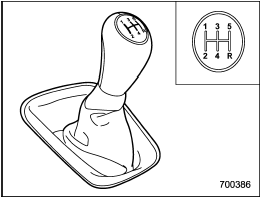Manual transmission

Manual transmission
The manual transmission is a fully synchromeshed, 5-forward-speed and 1-reverse- speed transmission.
The shift pattern is shown on the shift lever knob. When shifting from 5th gear to reverse gear, first return the shift lever to the neutral position then shift into reverse gear.
To change gears, fully depress the clutch pedal, move the shift lever, and gradually let up on the clutch pedal.
If it is difficult to shift into gear, put the transmission in neutral, release the clutch pedal momentarily, and then try again.

- Do not drive the vehicle with the clutch disengaged (i.e., when the clutch pedal is depressed) or with the shift lever in the neutral position. Engine braking has no effect in either of these conditions and the risk of an accident is consequently increased.
- Do not engage the clutch (i.e., release the clutch pedal) suddenly when starting the vehicle.
By doing so the vehicle might unexpectedly accelerate or the transmission could malfunction.

Shift into reverse ONLY when the vehicle has completely stopped. It may cause damage to the transmission to try shifting into reverse when the vehicle is moving.
See also:
Load and Speed Rating Descriptions
The load and speed rating descriptions
will appear following the size
designation.
They provide two important facts
about the tire. First, the number
designation is its load index. Second,
...
Photosensors
The mirror has a photosensor attached on both the front and back sides. During
nighttime driving, these sensors detect distracting glare from vehicle headlights
behind you and automatically dim ...
Trailer brakes
- Adequate size trailer brakes are
required when the trailer and its
cargo exceed 1,000 lbs (453 kg)
total weight.
- Do not directly connect your
trailer’s hydraulic brake system
to the ...


